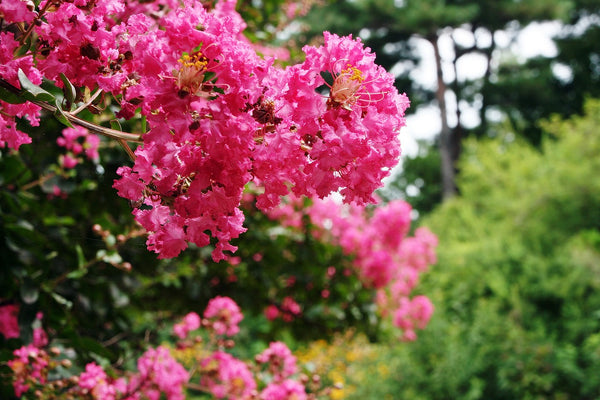Low-maintenance trees that flower for months: What’s not to love about the Crape Myrtle? Their blooms, fall foliage and attractive, peeling bark provide year-round interest in your garden and beyond.
Plus, Crape Myrtle Trees are tough. Thanks to their drought tolerance and heat resistance, they continue to bloom through harsh conditions. They can even tolerate urban smog and pollution, making them an excellent choice for city landscapes.
However, being tough doesn’t make them totally invincible! In the rare case that your tree develops an issue, here are a few quick and simple solutions to quickly restore its full health.
Why Isn’t My Crape Myrtle Blooming?
April showers bring May flowers, right? Well, this isn’t exactly the case with the Crape Myrtle. These trees bloom later in the summer, around June, so you won’t see crape flowers as early as you see roses or gardenias in your garden.
But wait if it’s midsummer and your tree still hasn’t bloomed, check its location. Crape Myrtle Trees need at least six hours of sunlight a day in order to bloom. Prior to planting your trees, watch your yard to see how much sunlight it gets and determine the best planting location from there.
Also, be sure to check your fertilizer. Fertilizers that are high in nitrogen will help your trees grow faster but can neglect the flowers. For the brightest blooms, use a fertilizer that’s high in phosphorous. A well-balanced fertilizer like formula 10-10-10 will be best for the overall health of your Crape Myrtle.

Oddly Colored Blooms?
Sometimes purple, pink and red blooms will emerge with a dull shade of color and can even be white. This doesn’t mean something is wrong with your tree – the weather can affect the color of the blooms.
The blooms contain a pigment called anthocyanin, which is activated by sunlight. If you have a lot of cloudy days in the late spring or early summer, the pigment of your Crape Myrtle may not become “activated.” By the next blooming cycle (in a few short weeks), the flowers should have their natural color.
Other environmental factors that affect the bloom color: the amount of water that your trees receive and the pH balance of your soil.
The Crape Myrtle is known for being drought tolerant, but it prefers a moderate amount of consistent moisture. Keep the soil for your trees moist but not oversaturated. If it doesn’t rain, your trees will need a long, slow and deep watering once or twice a month.
The Crape Myrtle prefers slightly acidic soil with a pH ranging from 5.0 to 6.5. To raise the acidity of your soil, add organic matter, peat moss or lime to it. To lower the acidity, add sulfur. Measure the pH balance of your soil with a pH tester, which can be found at your local gardening store.
Spots or White Powder on Crape Myrtle Leaves?
Like all trees, Crape Myrtles can develop fungus or mildew on their leaves. However, the Crape Myrtle does boast a higher resistance to pests and diseases than other flowering tree varieties, and when they are affected, the issues are easy to mediate quickly.
Our disease resistantvarieties include the Natchez, Sioux, Tonto, Dynamite, Red Rocket and more.
Aphids are tiny green bugs that crawl on leaves and bite into them for the tree’s nectar. They cause sooty mold by leaving their organic material on Crape Myrtle leaves. You can eliminate aphids naturally with neem oil or an organic pesticide. Good insects, like ladybugs or praying mantises, also eat the aphids.
Scales are small white or gray bugs that collect on the trunk of trees. They’re noticeable because their organic material causes the bark to turn black with sooty mold. Luckily, the mold can be sprayed and cleaned with a hose. You can also use neem oil or an all-natural pesticide spray to get rid of scales. Be sure to direct spray inside any cracks or crevices inside the trunk.


